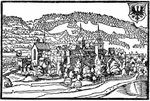Chefs: From 1st August 1743 Lieutenant General Friedrich Wilhelm von Dossow, later Field Marshal; from 8th January 1757 Lieutenant General Hereditary Prince and then Landgrave (from 1st February 1760) Friedrich II of Hesse-Kassel, later Field Marshal to 1786
First raised 1743.
IR45 remained in garrison in Wesel in 1756 and then moved out on March 24th 1757 when the French marched from the Lower Rhine into Hannover. It, along with other Prussian troops, temporarily joined the Duke of Cumberland's forces and eventually moved to Magdeburg. There the loss of 320 deserters was made good by new replacements and the regiment increased in size by 100 additional men.
In 1758 it advanced into Franconia and the Upper Palatinate in the Saxon Corps; by September it was at Pirna on the Müglitz. Under Wedell's command Fehrbellin was captured on September 28th and the corps finally reached Torgau on November 12th just before the Imperial Army arrived.
In 1759 after a fierce defence Torgau was surrendered and the garrison was granted an honourable capitulation with free departure. During the evacuation on 15th August the troops of Prince Carl zu Stolberg tried to persuade Saxons and deserters of the Imperial army to desert IR45. Its commander Colonel von Wolffersdorff had some of them shot and threatened to take the Prince prisoner. Thereafter the evacuation proceeded without further incident.
Under General von Wunsch along with the forces which had formerly held Wittenberg and Torgau they retook both places in night attacks but arrived too late at Reichenberg to prevent the surrender of Dresden. Wunsch doubled back to Torgau and drove away the Imperial Army of 14000 at Zinna with only 5000 men, bluffing the enemy into thinking he had far more troops. Half of the 600 enemy prisoners were taken into Prussian service. Finck took over the corps and sent Wunsch to occupy Leipzig and they drove back enemy forces at Korbitz on September 21st. On November 18th Finck's Corps reached Maxen where it was badly isolated. On November 20th it was overwhelmed by vastly superior enemy forces and made to surrender on the 21st. Most of IR45 was captured, although some men managed to escape.
One battalion was reformed in 1760 and was with Stutterheim's Corps opposing the Russians from October 5th to 9th. It then occupied Berlin from October 21st.
In 1761 the regiment moved into the fortified camp at Kolberg with the Württemberg Corps at the beginning of June but, despite reinforcements, the camp could not be held against the Russians. The regiment escaped.
In 1762 the two battalions of IR45 fought in Bevern's Corps between Fischerberg and Spitzberg at Reichenbach, during the siege of Schweidnitz between August and October. Schweidnitz eventually surrendered on October 9th.
In 1763 the battalion included 76 Prussians, 95 Saxons and 779 "foreigners", a total of 950 men on active duty.
Christopher Duffy
Army of Frederick the Great says this of the regiment: "Some of the worst troops of all piled up in the regiment of Hessen-Kassel (No.45) which became the repository of all the criminals whom the squeamish Landgrave could not steel himself to put to death."
And this was the uniform in 1756:

































































